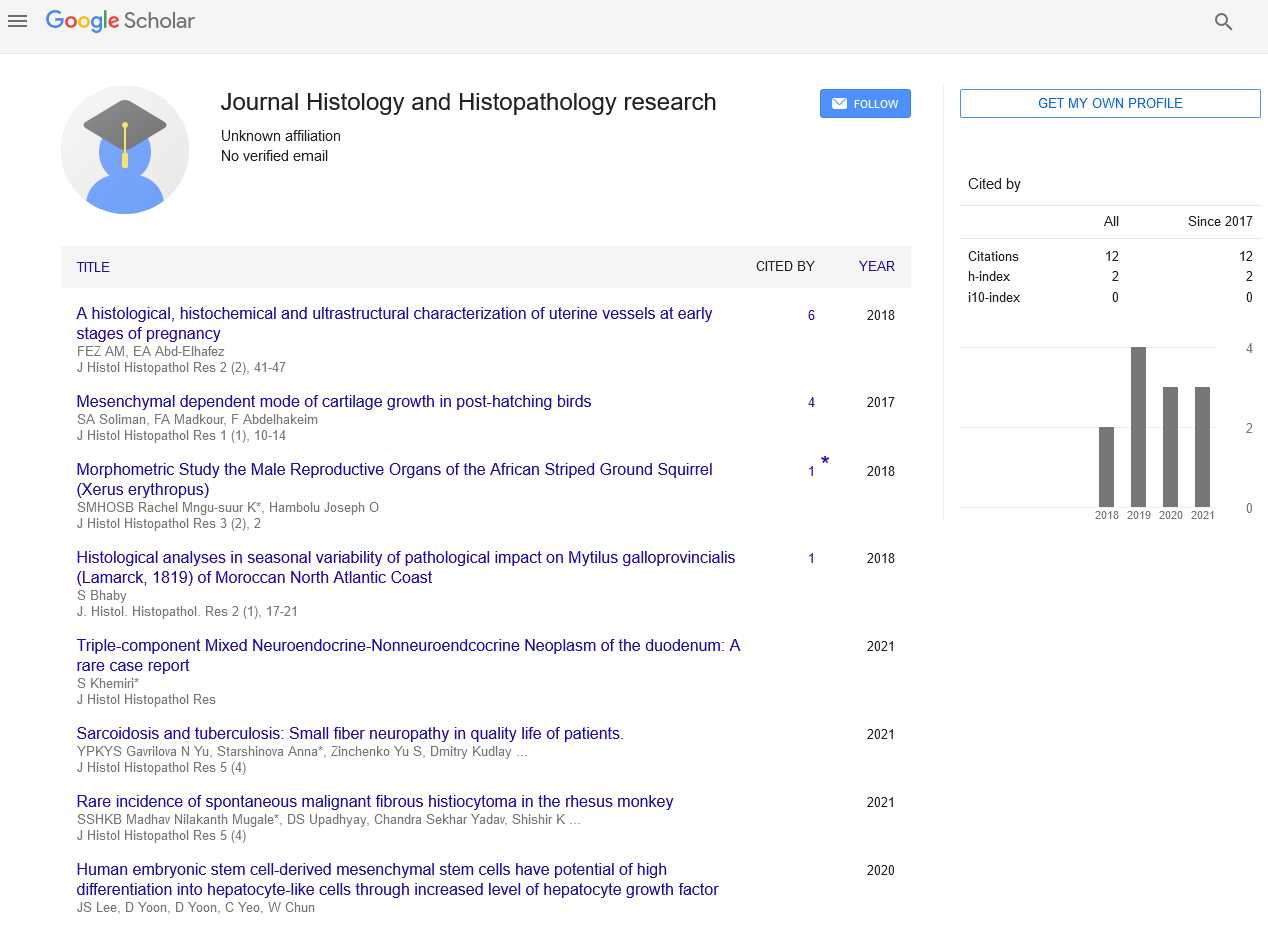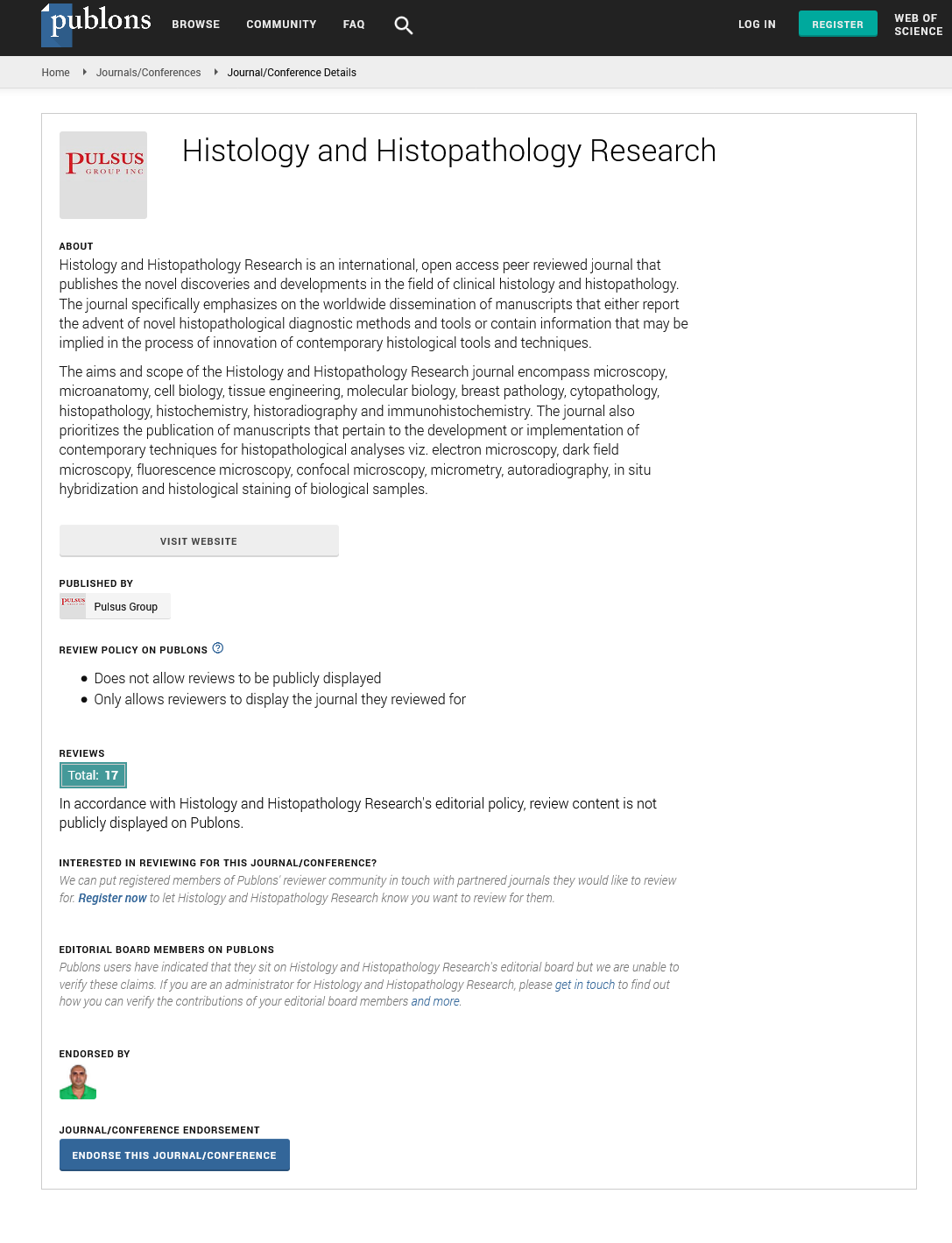Tumor histology revealed by the histological patterns of head and neck tumours
Received: 02-Mar-2023, Manuscript No. pulhhr-23-6342 ; Editor assigned: 04-Mar-2023, Pre QC No. pulhhr-23-6342 (PQ); Accepted Date: Mar 18, 2023; Reviewed: 13-Mar-2023 QC No. pulhhr-23-6342 (Q); Revised: 15-Mar-2023, Manuscript No. pulhhr-23-6342 (R); Published: 28-Mar-2023, DOI: 10.37532/pulhhr.23.7 (1).1-2
Citation: Quinn S. Tumor histology revealed by the histological patterns of head and neck tumours. J Histol Histopathol Res 2023;7(1):1-2.
This open-access article is distributed under the terms of the Creative Commons Attribution Non-Commercial License (CC BY-NC) (http://creativecommons.org/licenses/by-nc/4.0/), which permits reuse, distribution and reproduction of the article, provided that the original work is properly cited and the reuse is restricted to noncommercial purposes. For commercial reuse, contact reprints@pulsus.com
Abstract
In order to diagnose oral and maxillofacial malignancies, this article emphasises the foundation for genesis and significance of tumour patterns. This page lists the histological subpatterns and patterns of head and neck tumours. Although undifferentiated tumours continue to be difficult for histopathologists to diagnose, an attempt has been made by characterising the histological patterns and subpatterns of the tumours in order to do so and then to adopt a precise treatment plan for the same.
Introduction
These specific patterns are crucial for making a histopathological diagnosis because they are histological patterns and/or subpatterns that are distinctive of certain tumours or groups of tumours. It is easier to diagnose and provide the proper treatment when one is aware of the varied patterns and subpatterns present in different tumours. Epithelial mesenchymal cell contact and the interaction of distinct cytoskeletal organelles of these cells are regarded to be the underlying causes of varied tumour types. During embryonic development, tissue repair after injury, carcinogenesis, and tumour metastasis, Epithelial Mesenchymal Transition (EMT) has been suggested as a multifunctional process that makes it easier for cells to be repositioned and redistributed.
One of the most widespread diseases in the world, Head and Neck Cancer (HNC) is said to be on the rise in nations with little resources. There aren't many published studies on head and neck malignancies in Tanzania, particularly specifically at Bugando Medical Center. This paper outlines the clinicopathological characteristics of HNC in our local area and emphasises the difficulties in treating this condition.
Since certain histological patterns and subpatterns are indicative of particular tumours or subgroups of cancers, they are crucial for the histopathological diagnosis. The diagnosis and administration of the proper treatment are aided by understanding of the varied patterns and subpatterns present in different tumours. It is believed that interactions between epithelial mesenchymal cells and their diverse cytoskeletal organelles form the foundation for varied tumour types. It has been suggested that Epithelial Mesenchymal Transition (EMT)is a flexible process that promotes cellular redistribution and repositioning during embryonic development, tissue repair following damage, carcinogenesis, and tumour metastasis.
Numerous specialised tissues from all lineages are present in the head and neck area, giving birth to a wide range of various cancers. The identification of their histological and molecular properties has led to the description of novel cancer types and subtypes in recent years. Due to differences in clinical presentation, prognosis, and therapy, some have been legally recognised as different illnesses in the most recent classifications from the World Health Organization (WHO) and American Joint Committee on Cancer. This specifically relates to oropharyngeal, sinonasal, and salivary gland cancers. We outline the most current changes to head and neck cancer categorization, histological traits, and molecular characteristics in this review. The outcomes, treatment choices, including potential for targeted medicines, and clinical and radiological aspects are all reviewed.
Biphasic tumours
Salivary gland tumours are diverse, and the majority of them have histological and genetic similarities with lacrimal gland, breast, and skin tumours. They can be roughly classified as monophasic or biphasic tumours. While luminal and myoepithelial cell components are always present in biphasic tumors, monophasic tumours can be made entirely of luminal, secretory carcinoma, myoepithelial (myoepithelioma and myoepithelial carcinoma), or basal cell components. The number of carcinoma types has expanded from 5 in the WHO classification of 1972 to 22 in the 2017 edition, while over the same time period, the number of benign tumours has increased from 4 to 11, with new subtypes being reported within each tumour type. The most prevalent and recently identified entities with newly developed targeted therapeutics are discussed here, along with unique molecular characteristics in well-known tumour forms
Malignant neoplasms called head and neck cancers can develop in the salivary glands, ear, scalp, oral cavity, paranasal sinuses, nasopharynx, hypopharynx, and oropharynx. They are a significant source of illness and mortality and a significant global public health problem. Due to the interference with fundamental life processes including breathing, swallowing, speaking, hearing, vision, taste, and odor, head and neck malignancies are linked to significant morbidity. According to epidemiological data, head and neck cancers are the tenth most prevalent cancer in the world, and their prevalence has significantly increased over the previous 10 years. There are currently over 650,000 new instances of head and neck cancer reported each year globally, and the frequency of the disease looks to be rising in emerging nations.
Neoplastic luminal and myoepithelial cells in adenoid cystic carcinoma are largely homogenous. The extracellular substance that resembles the basal membrane is produced in excess by the myoepithelial cells, and the luminal component is the less significant of the two. Solid regions determine the histological grade, with >30% solid areas qualifying as solid-type ACC, which has a poor prognosis. Cribriform and tubular development patterns are frequently mixed together in variable proportions. With only intraneural invasion being linked to worse overall and recurrence-free survival, ACC has the ability to infiltrate beyond the clinically evident lesion due to its tendency for intra- and perineural invasion. By emphasising the luminal cells and myoepithelial markers, as well as calponin in the myoepithelial cells, Epithelial Membrane Antigen (EMA) and ACC can be used to show that the condition is biphasic.
The primary location, tumour stage, patient treatment preferences, and practitioner experience all influence how head and neck malignancies are treated. Approaching the neck lymph nodes depends on the original location and severity of the illness. The prognosis and survival probability of a patient with head and neck cancer are frequently determined by the clinical stage of the illness at diagnosis, with early diagnosis producing the best results. However, the results of head and neck cancer therapy in resource-constrained nations like Tanzania have been subpar since the majority of these patients arrive at the hospital after their disease has already progressed to the point when only palliative care is an option.






